The Great Ocean Road Part I
According to tourism statistics, more people travel the Great Ocean Road to visit the Twelve Apostles than Kakadu and Uluru combined. As one of the most popular highlights of any visit to Australia, the vast part of the Great Ocean Road stretches from Torquay all the way to Portland (about 4 hours drive via the inland route on Princes Highway from Melbourne).
With all that distance, the environment that one traverses on a trip down the Great Ocean Road would be incredibly diverse, ranging from the Surf Coast (Torquay to Apollo Bay - for the biggest waves a surfer can desire) to the Shipwreck Coast (Cape Otway to Warrnambool - the coastal bits where many shipwrecks occurred in the 19th century). Travelling just half an hour north from the Great Ocean Road would lead you to rainforests, waterfalls, volcanic territory and quaint country towns. So a trip down the Great Ocean Road would have enough varied activities for a group with different interests.
Better yet, one now has the option to either drive down the Great Ocean Road (which most visitors choose) or to walk part of it in the Great Ocean Walk, which covers about 91km from Apollo Bay to Glenample Homestead near the 12 Apostles. We drove of course….
Our trip took us as far as Port Fairy, which is about 290 km west of Melbourne. The beauty about travelling the Great Ocean Road is that you can decide how far you want to venture as there are many turn-offs along the way leading north up to the inland route back to Melbourne. On hindsight, I did wish we had taken it a little easier and not ventured so far this time around as most of our days were quite packed. It's also prudent to remember that driving times between attractions will also take slightly longer owing to the winding roads and occasional offroad conditions (particularly at the national parks).
Still, we packed in a nice variety of activities ranging from exploring the quaint fishing village of Port Fairy and the other little country towns we passed through, climbing up the many lighthouses along the coast, trekking through rainforests to see waterfalls, attempting to see glowworms at night and aborting the same as it was terrifyingly dark and our torch was but a tiny beam of light in a pool of black, visiting a migratory bird sanctuary island (at night in the pitch black again and then the next day when it's light) and a wild-life reserve set in a dormant volcanic crater…..
I could go on and on about the fun we had, the places we'd visited and the people we met. Instead, here's a selection of some of our memories:
The views and townships we passed through

Each of the towns we passed through had their own character. We were lucky when we rolled into Apollo Bay on Saturday that their weekly market was in session - so we took the chance to buy some excellent jam and check out the wares on offer.

A buying some yummy watermelon, lemon and orange honey jam in Apollo Bay
Camperdown is an excellent example of an old country town and nowhere is it evident that it is also cattle country than by this sign displayed next to the town's historic clock tower.

Port Fairy is a charming (if slightly sleepy) fishing village, which has been gentrified by the arrival of retired Melburnians. Lots of very good cafes and top notch restaurants (which I will post about next) would be found on the single stretch of shops down its "high street" and Port Fairy has fast acquired a reputation as a foodie town - indeed, there are no less than 4 restaurants in Port Fairy listed in the Age Good Food Guide and the Australian Gourmet Traveller but seeing that we only had 1 night there, we had to settle for just one of those 4 restaurants! Other attractions include a thriving artist community scattered around the town, fresh seafood hauled in by the fishing vessels and a migratory bird colony on a nearby island. Take a lovely stroll down the River Moyne and better yet, book one of the B&Bs (bed and breakfast) places with a view overlooking the river. Unfortunately for us, the weather when we were there was rainy, overcast and extremely cold.
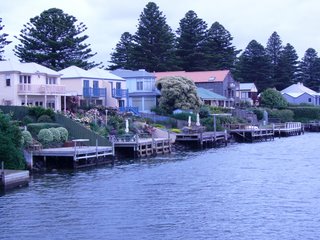
A view of the many B&Bs along the River Moyne - we stayed in Gobles Mill House (the grey building with the red roof)
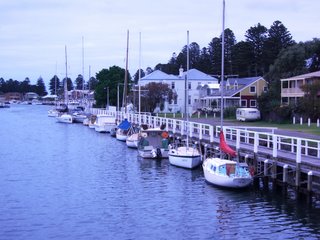 Further along this stretch is the port where fishermen pull up and the fishermen's co-op where you can buy fresh fish, crayfish and even abalone (in season)!
Further along this stretch is the port where fishermen pull up and the fishermen's co-op where you can buy fresh fish, crayfish and even abalone (in season)!
Driving back along the Princes Highway, we were treated to a different type of view altogether of rolling hills, golden pastures dotted with sheep and cows and miles and miles of these dry stone walls. If you look closely, you'll notice that these walls have been constructed without the aid of cement or any binding agent. Drystone-walling is an artform in itself, handed down from generation to generation and nowhere is this art more in evidence than in the countryside surrounding Camperdown and Colac.
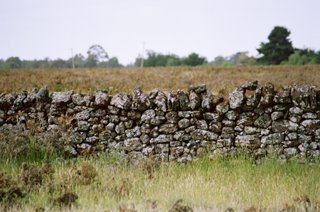
Lighthouses a plenty

Split Point Lighthouse
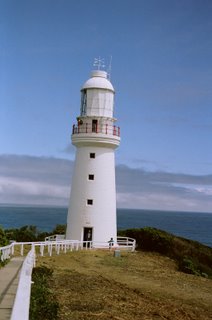 Cape Otway Lighthouse - the oldest lighthouse in Victoria
Cape Otway Lighthouse - the oldest lighthouse in Victoria 
Here is A plodding along on our walk around Griffith Island to the lighthouse at its extreme point

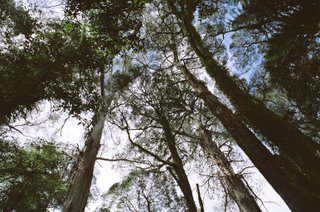
Anyone intending to do a "glowworm" trek at night at Melba Gully or Kennett River is definitely encouraged to check out these places in the daytime. A and I went to Melba Gully our first evening and couldn't find out way from the carpark to the start of the trail in the pitch black darkness, even with the help of our torch and the car's headlights. Needless to say that in the dark, one does get a little disoriented and everything takes on an extra sinister aspect so not seeing anyone around (but several cars in the carpark) was enough to spook us badly so that we slunk back to the B&B without having seen any glowworms.
The Twelve Apostles and Lord Ard Gorge

One of the most famous attractions along the Great Ocean Road, the Twelve Apostles probably need no introduction. Lord Ard Gorge is another beautiful rock formation further down from the Twelve Apostles, and is also where the sailing ship, the Lord Ard, was shipwrecked, leaving only 2 survivors. The sinking of the Lord Ard is retold every night in a lights and laser show at Flagstaff Hill (at Warrnambool).
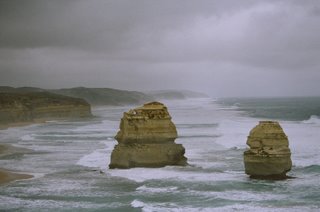
Unfortunately, when we reach the Twelve Apostles, nature conspires against us and the skies go all dark and broody. Hence our dramatic stormy looking shots!
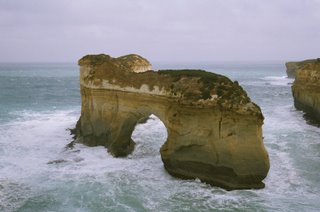
As our tummies are rumbling and we need to turn off the Great Ocean Road to get to Camperdown for the night, we decide to skip the rest of the rock formations after we visit Lord Ard Gorge.
All the animals we spotted

On the plus side, fauna was in abundance on our trip. We started off with a sighting of koala bear mothers and their cubs in the trees when driving along the winding road away from the Cape Otway lighthouse. Cars would progressively pull over to the roadside to stand beneath the trees to check out one of Australia's national icons in the wild. Ignoring the threat of snakes in the bushes (actually, A told me that there aren't any snakes in bushland but he was WRONG!), we plunged into the scrub to check out that koala mama's extended family. Luckily I was toting my long range lens and was able to capture quite a few shots of the happy family.

We spot plenty more animals along our drives, including what looked like a hedgehog ambling along the highway (A tells me its actually an echidna). The bumper crop of sightings comes on our last day when we check out the shearwater bird colony on Griffiths Island and visit the Tower Hill Game Reserve.
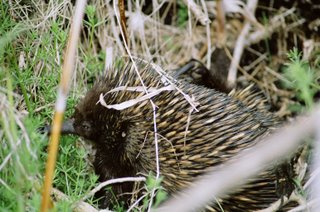
We don't see very many shearwater birds (being out fishing the whole day) although we do see evidence of their 'homes' - they nest in burrows much like puffins do. What's quite interesting to us is that every year, these birds fly 15,000 km from their wintering grounds in the Aleutian Islands and the Kamchatka Peninsula to Griffiths Island to next. Individual birds return to the same nest burrow they occupied the previous year and what follows is several months of housekeeping, feeding and nesting. The young are eventually left by their parents who make their way back to their wintering grounds and these young chicks are able to eventually find their way back there without the guidance of the older birds! Griffiths Island is also an ornithologist's paradise, with its proliferation of sea birds, To our surprise, I spy a joey in the midst of this island (A thought it was a rock initially until it move).

Later on that afternoon, we went for a ramble in the Tower Hill Game Reserve. Tower Hill Game Reserve is noted for being located in a dormant (not extinct!) volcanic crater. Noting that the signboard warns us to be careful of poisonous snakes (leading me to scold A thoroughly for misleading me about snakes in Australian bushland), we make our way through the scrub and have lovely views of the volcanic crater.
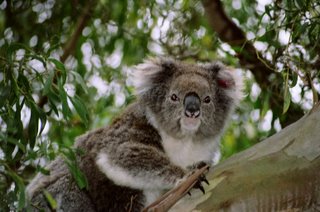
Along the way, we spot emus and their chicks, an echidna hiding in the bush and a ditzy koala in the carpark. What amused me most, prior to spotting the koala ambling on the ground (a rare occurrence as they are mostly treebound during the day) was that A said something about spotting a strange-looking dog. One glance told me it was a koala and I grabbed my camera, yelling to him to follow at the same time. Apparently, the koala had climbed up a wrong tree instead of a eucalyptus and proceeded to do the same thing again in our presence before finally finding the correct tree to join his mate. It must have been a little disconcerted to find an audience observing his ditziness!
Seeing so many animals in the wild was a nice ending to a great trip. Indeed, the ditzy koala provided many laughs on our long drive back home.
Labels: Holidays, Other activities

0 Comments:
Post a Comment
<< Home